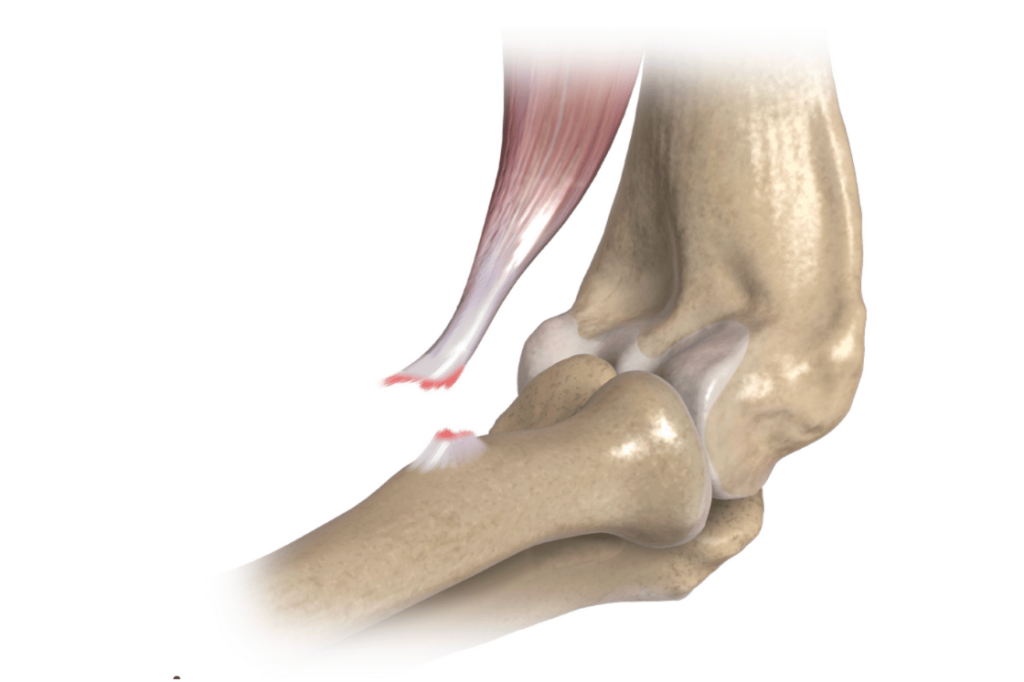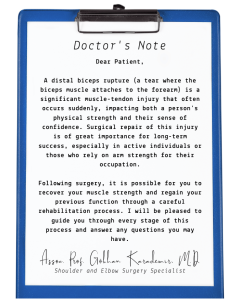The biceps muscle is an important muscle that extends from the shoulder to the elbow, responsible for both bending the arm (flexion) and rotating the forearm outward (supination). The rupture of this muscle’s lower (distal) tendon, located at the elbow, usually occurs as a result of sudden trauma. This condition is called a “distal biceps rupture” and typically occurs during activities like heavy lifting, sudden loading, or abrupt pulling motions.
Following the tendon rupture, patients often describe a sudden “popping” sensation, pain and swelling in the elbow, and a noticeable distortion in the muscle’s shape. The loss of strength in the arm is especially evident during the motion of turning the palm upward (supination). Bruising around the elbow and the upward retraction (displacement) of the muscle are typical findings.
Distal biceps rupture is most commonly seen in men and occurs more frequently in the dominant arm (e.g., the right arm for a right-handed person). Diagnosis is readily confirmed through a clinical examination and MRI (Magnetic Resonance Imaging).

Surgical treatment is generally recommended to fully restore muscle strength and function. A non-surgical (conservative) treatment option may be considered for some elderly patients or those with low physical demands; however, the resulting loss of strength may be permanent. Surgical repair is based on the principle of reattaching the ruptured tendon to the bone. This procedure is typically performed as open surgery through a small incision, using special screws or fixation devices (such as an Endobutton) to secure the tendon.
Timely surgical intervention prevents both the cosmetic deformity and the functional loss. In the initial weeks, the tendon is protected with an arm sling and limited motion; a physical therapy process is initiated thereafter. Most patients achieve full strength and range of motion within 2–4 months.

Duration of Surgery: Approximately 45–60 minutes
Type of Anesthesia: General anesthesia or a nerve block (regional anesthesia)
Surgical Method: Open surgery, performed through a small incision
First day: 4–5
First week: 3–4
After the 2nd week: 1–2
Typically 1 night in the hospital
First 2 weeks: Protection with an arm sling and splint, restricted movement
3rd week: Passive motion exercises begin
5th–6th week: Active motion and strengthening exercises
3rd month: Return to daily life and functionality
4th–6th month: Return to sports and heavy activities
First dressing change: 2nd day
Wound check: 1st week
Suture removal: 10th day (if necessary)
Surgery is recommended for active individuals and patients whose work requires manual labor. If not surgically treated, the loss of strength and the cosmetic deformity may be permanent.
The arm is protected for the first 2 weeks. Movements begin in the 3rd week. It generally becomes safe for daily use by the 6th week.
No. The exercises shown to the patient, which they can perform on their own, are sufficient to restore shoulder and elbow motion and increase muscle strength after surgery.
With the correct surgical technique and proper rehabilitation, the risk of re-rupture is low. However, it is necessary to avoid sudden and uncontrolled heavy strains.
The incision is generally small and placed in a cosmetically favorable area. It fades over time, and most patients are not left with a bothersome scar.